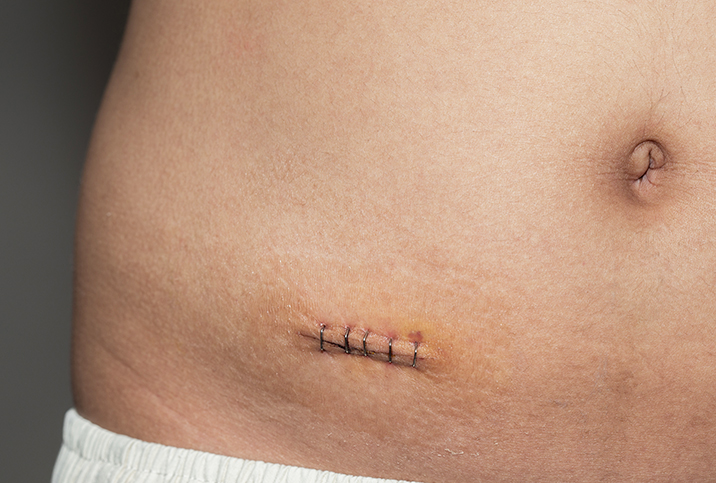What Are the Pros and Cons of Surgical Treatment for Endometriosis?

Endometriosis is a condition in which tissue resembling the lining of the uterus (the endometrium) grows outside of the uterus and can cause painful periods and even infertility. Symptoms vary drastically from woman to woman, meaning diagnosis can take a long time, and often, a true diagnosis requires surgical intervention. That means many patients must weigh the pros and cons of surgical treatment for endometriosis if they want relief from their symptoms.
While the advent of laparoscopic endometriosis treatment minimized scarring and shortened recovery time, such intervention is still a surgical procedure that can shock your system. Laparoscopic procedures involve filling the abdominal cavity with air and creating multiple small incisions in the abdomen and navel. These incisions typically heal in a few weeks, but they sometimes leave painful scar tissue that can take months to heal.
The actual treatment for endometriosis involves a laser or electrocautery, which can both be used to ablate or destroy the endometrium-like tissue growths in your uterus, fallopian tubes, ovaries and, sometimes, the large and small intestine. This treatment often happens at the same time as diagnosis, depending on the extent of your condition.
Unfortunately, these tissues can grow back as quickly as your next menstrual cycle, but that doesn't mean more surgery is imminent. Hormonal medications usually follow laparoscopy to shrink any remaining endometriosis and prevent new growth. Often, laparoscopy is repeated if further treatment is needed. A hysterectomy is the final treatment for endometriosis, but it is avoided when possible. Understanding the pros and cons of any surgical treatment is essential to making the best decision.
Endometriosis surgical treatment pros
It’s important to remember that while surgery is a treatment for endometriosis, it is not the only one. In the past, surgical intervention was customary, but now it is considered a last resort or for severe cases when other complications arise, such as those that prevent healthy reproductive or digestion functions.
Surgical intervention can help overcome endometriosis complications in the following ways:
- Reduces pain. When your pain becomes so severe you cannot function during or in between menstruation, removing the endometrium-like overgrowth can improve bowel and reproductive function and alleviate pain.
- Improves fertility. If you have been diagnosed with endometriosis and are unable to conceive, your doctor may recommend surgical intervention to eliminate endometrial tissue so you can conceive naturally.
- Prevents regrowth. In situations where you experience regrowth but your doctor is not yet ready to perform a hysterectomy, performing a laparoscopy will allow for the removal of the endometriomas (the cysts that grow as a result of the condition), which can prevent long-term regrowth.
While surgical treatments can help alleviate symptoms, there is no cure for endometriosis, and because regrowth is likely, some women choose to have a partial hysterectomy at the same time as the endometriomas' removal. Know, however, that for the complete treatment of endometriosis, removal of the cervix, the uterus, the fallopian tubes and the ovaries is required. Leaving the ovaries doesn't eliminate the source of estrogen, which is what causes endometrial tissue to grow, and it could recur in the pelvic lining and the ovaries.
Endometriosis surgical treatment cons
When your endometriosis has reached a severity where surgical intervention is needed, it’s likely this will not be your last. With any surgery, even laparoscopic, there are risks and complications. Talk with your doctor and exhaust alternatives before making this decision.
While the benefits may outweigh the risks, it’s important you understand you may be trading one set of symptoms for another:
- Recovery time. Your experience after surgery is just as personal as your experience with endometriosis. Most women recover quickly with minimal complications, but prolonged pelvic pain and infections are always a risk with any laparoscopic surgery.
- Scar tissue. While the scar tissue from one laparoscopic procedure is minimal, repeated procedures can increase the amount of scar tissue and pain caused by it. If you are considering additional surgeries, you may want to think about the long-term pain associated with surgical scar tissue.
- Surgical effectiveness. For many women, repeated surgical procedures are necessary. However, as research continues, it’s clear the skills of your surgeon often determine the effectiveness of the procedure, so consider finding a surgical specialist.
The most important consideration for surgical intervention, especially a hysterectomy, is your quality of life before and after the procedure. As technology continues to improve, surgery is not as invasive as it once was and the success rates are much higher.
Consider all options
The solution to endometriosis is complex and should be considered carefully. It’s important you weigh your options and investigate the possible outcomes with your doctor. If possible, ask to be referred to a surgeon who specializes in endometriosis operations Regardless of your prognosis, don’t let the myths about endometriosis stop you from seeking treatment that could rid you of symptoms.

















